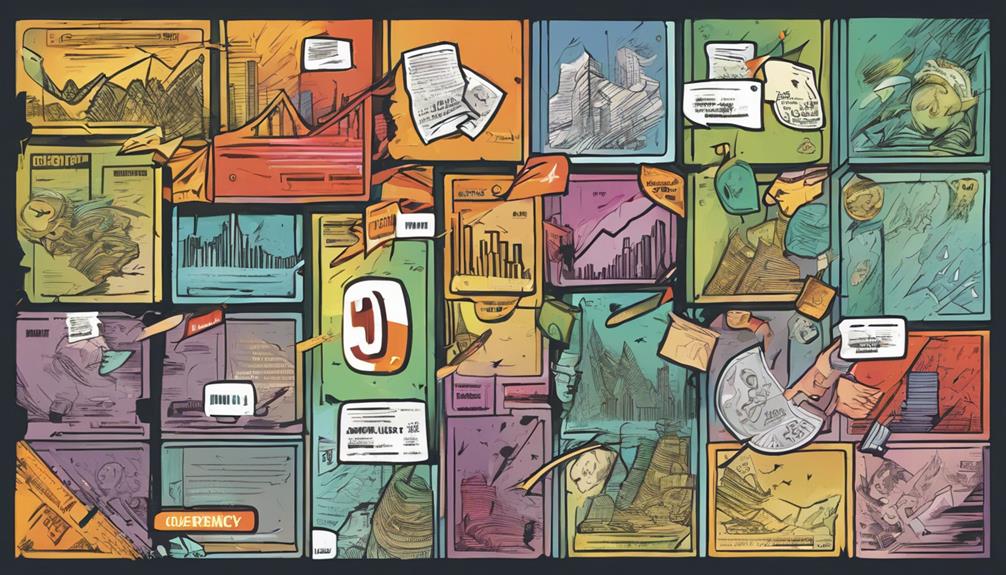Understanding how currency fluctuations can impact your investments is pivotal. Exchange rate movements directly affect the value of your foreign investments. Appreciation may boost returns, while depreciation can decrease profits. Keeping an eye on exchange rates is essential to managing currency risk and making informed choices. Utilizing currency-hedged ETFs can help safeguard your investments from currency volatility. By grasping the nuances of currency fluctuations, you can take steps to protect and optimize your investment portfolio. Explore further insights to enhance your understanding of this vital aspect of global investing.
Key Takeaways
- Currency fluctuations affect investment values through exchange rate movements.
- Appreciating currencies can lead to higher investment returns.
- Depreciating currencies may result in reduced profits.
- Understanding currency fluctuations is crucial for maximizing returns.
- Currency-hedged ETFs help mitigate currency risk and align investments.
Understanding Currency Fluctuations

Understanding currency fluctuations is important for investors seeking to navigate the complexities of the global market. Currency fluctuations, driven by factors like economic indicators and geopolitical events, can have a significant impact on the returns of foreign investments. For example, if a US investor holds stock in a European company, the strength of the Euro relative to the US dollar will directly affect the returns on that investment. Understanding and predicting the impact of currency fluctuations can help investors make more informed decisions when managing their international portfolios. Additionally, hedging strategies can be employed to mitigate the impact of currency fluctuations on foreign investments.
Exchange rates constantly move, affecting the profitability of investments denominated in foreign currencies. To effectively manage foreign currency risk in investment portfolios, investors must monitor currency movements closely.
By staying informed about currency fluctuations, investors can make informed decisions to hedge currency risk and protect their investments from potential losses. This proactive approach to risk management is critical in the dynamic landscape of global financial markets, where even small changes in exchange rates can have a notable impact on returns.
Understanding how currency fluctuations influence investments is important for building a resilient and profitable investment strategy in an increasingly interconnected world.
Investment Risks and Rewards

Investors face a balancing act between risks and rewards when managing the impact of currency fluctuations on their investments. Currency fluctuations can greatly influence the value of investments due to exchange rate movements. Investing in appreciating currencies can lead to higher investment returns, while depreciating currencies may result in reduced profits.
To maximize returns and effectively manage risks, understanding how currency fluctuations affect investments is crucial. In this scenario, currency-hedged ETFs play a key role in helping investors mitigate currency risk and align their investments with their objectives.
Currency-Hedged ETFs for Investors

Currency-hedged ETFs offer investors a strategic solution to mitigate the impact of foreign currency fluctuations on their returns. These financial instruments are designed to help investors manage currency risk when investing in international markets. By using currency-hedged ETFs, you can maintain exposure to foreign markets while reducing the potential negative effects of currency volatility on your investments. These ETFs employ tools like forward contracts to offset currency fluctuations, allowing you to focus on the investment fundamentals of the foreign markets you are interested in. The primary goal of currency-hedged ETFs is to provide returns that are closely aligned with the performance of the underlying assets, excluding the impact of currency movements. This strategy can help you navigate the complexities of investing in foreign markets while minimizing the influence of currency fluctuations on your overall returns.
| Currency-Hedged ETFs | Benefits |
|---|---|
| Mitigate currency risk | Maintain exposure to markets |
| Reduce currency volatility | Focus on investment fundamentals |
| Align returns with asset performance | Offset foreign currency fluctuations |
Managing Currency Risk Effectively

To effectively manage currency risk in your investments, consider utilizing strategies like currency-hedged ETFs. These tools can help shield your investment returns from adverse movements caused by currency fluctuations. Understanding the impact of currency fluctuations is essential for successful risk management.
Here's how you can manage currency risk effectively:
- Utilize Currency-Hedged ETFs: Invest in ETFs that hedge against currency risk to protect your investment performance.
- Monitor Spot Exchange Rates: Keep an eye on spot exchange rates to assess potential effects on your investments and adjust your strategy accordingly.
- Mitigate Losses and Optimize Returns: By actively managing currency risk, you can mitigate losses and optimize returns, especially in volatile market conditions.
Impact on Global Economy

Currency fluctuations have significant implications for the global economy, influencing trade balances, inflation rates, and interest rates. Exchange rate movements play a pivotal role in determining a country's competitiveness in international markets and can impact the cost of imported goods. When a currency depreciates, it can boost exports but may lead to imported inflation. Conversely, a stronger currency can reduce export competitiveness. Central banks often adjust monetary policies in response to currency fluctuations to maintain economic stability. This is essential for ensuring that inflation remains in check and that interest rates are at appropriate levels to support economic growth.
To illustrate the impact of currency fluctuations on the global economy, consider the following table:
| Aspect | Impact |
|---|---|
| Trade Balances | Fluctuations can affect export competitiveness and import costs. |
| Inflation Rates | Currency movements can lead to imported inflation or export-led deflation. |
| Interest Rates | Central banks adjust rates to counter currency effects on the economy. |
| Competitiveness | Exchange rate movements determine a country's ability to compete globally. |
| Investment Decisions | Uncertainty in currency markets can influence investment choices. |
Frequently Asked Questions
What Are the Negative Effects of Currency Fluctuation?
Currency fluctuations can decrease investment returns, reduce profitability in foreign investments, erode the value of dividends and interest income, increase transaction costs, and undermine the overall value of a diversified investment portfolio. Be mindful of these effects.
Why Is It Important for Currency to Fluctuate?
It's important for currency to fluctuate because stable currencies can hinder economic growth. By allowing currencies to move freely, economies can adjust to external factors, promoting competitiveness and trade. Embracing fluctuations fosters a dynamic global market.
How Does Currency Affect Stocks?
Currency affects stocks by influencing profits from foreign investments. U.S. stocks historically outperform due to a strong dollar. You can align currency effects with market trends or hedge against fluctuations using currency-hedged ETFs for better returns.
How Does Foreign Exchange Affect Trade and Investment?
Foreign exchange impacts trade and investment by affecting import costs, export competitiveness, and attracting foreign investments. Understanding these dynamics is vital for making informed decisions and ensuring economic growth and trade relationships remain stable.
Conclusion
So, as you can see, keeping an eye on currency fluctuations is vital for protecting your investments.
By understanding the risks and rewards, considering currency-hedged ETFs, and managing currency risk effectively, you can navigate the ups and downs of the global economy with confidence.
Remember, staying informed and proactive is key to ensuring your financial stability in an ever-evolving market landscape.









